Duct Insulation Cost Estimator
Duct insulation is a crucial component in HVAC systems, playing a significant role in enhancing energy efficiency, maintaining indoor comfort, and reducing operational costs. Proper insulation of air ducts ensures that the heated or cooled air delivered through the system reaches its destination without significant energy loss. Estimate Florida Consulting provides expert cost estimator services to help you plan and execute your duct insulation project with precision, ensuring that your project stays within budget while delivering optimal performance and efficiency.
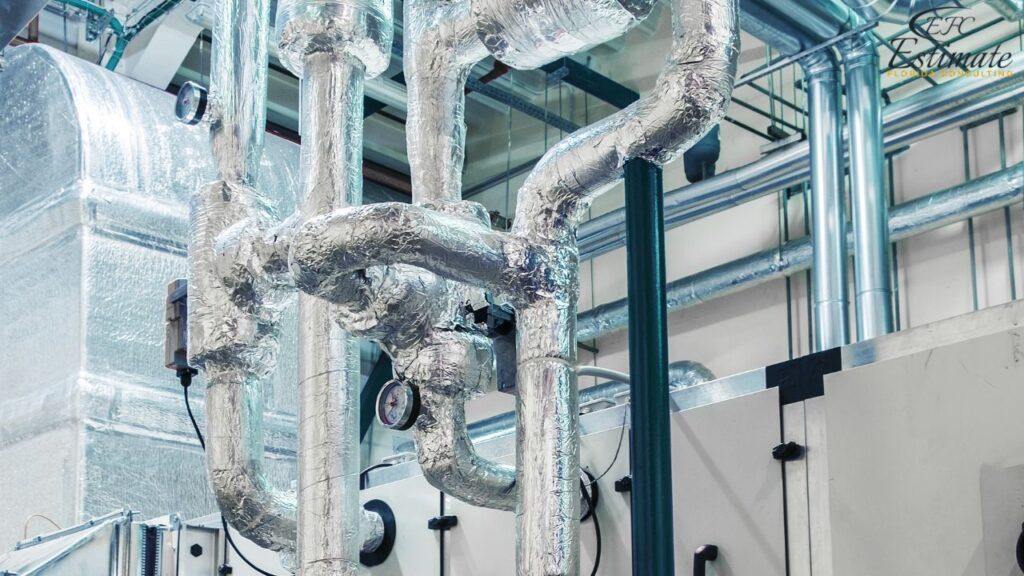
Factors Influencing Duct Insulation Costs
The cost of insulating ducts can vary widely depending on several factors, including the type of insulation, the size and length of the ducts, labor costs, and additional expenses such as sealing and repairing ducts. Understanding these factors will help you estimate the total cost of your project and make informed decisions that align with your budget. Each factor plays a crucial role in determining the overall expense, and being aware of these variables can help you optimize your investment in duct insulation.
Gas Line Installation Costs
Installing a new gas line from the gas supply throughout the house now typically costs between $1,690 and $4,550, with most homeowners spending an average of $2,600, or approximately $26 per linear foot. Costs largely depend on the number of appliances and the distance from the gas supply.
ange | Average Cost |
National Average Cost | $2,600 |
Minimum Cost | $920 |
Maximum Cost | $12,350 |
Average Range | $1,690 – $4,420 |
Type of Duct Insulation: Fiberglass, Foam, or Reflective
The type of insulation material you choose is one of the most significant factors affecting the cost of your duct insulation project. Different materials offer different levels of insulation, durability, and ease of installation, which can impact both the initial cost and the long-term benefits. Selecting the right type of insulation for your specific needs is essential to achieving the best balance of performance and cost-effectiveness.
Type of Duct Insulation | Average Cost per Linear Foot |
Fiberglass Insulation | $2.60 – $7.80 |
Foam Insulation | $5.20 – $13.00 |
Reflective Insulation | $3.90 – $9.10 |
Fiberglass Insulation:
Fiberglass is one of the most common materials used for duct insulation. It is available in the form of duct wrap or pre-formed duct insulation. Fiberglass is relatively affordable, with costs ranging from $2.60 to $7.80 per linear foot. It provides excellent thermal insulation and is resistant to moisture, making it a popular choice for both residential and commercial applications. Fiberglass is also fire-resistant and offers sound-dampening properties, which can further enhance the comfort and safety of your space. However, it requires careful handling during installation to avoid skin irritation or respiratory issues.
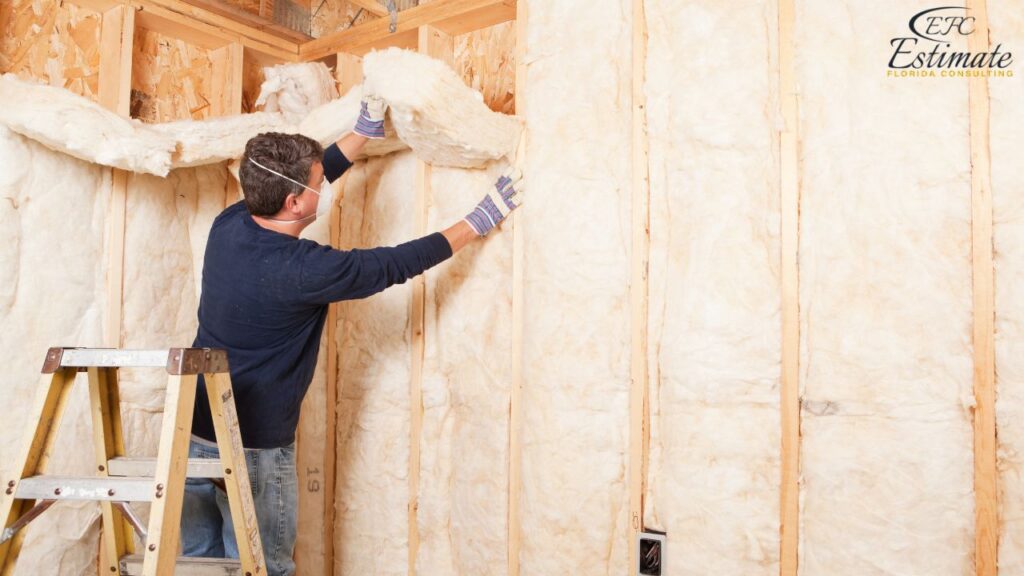
Foam Insulation:
Foam insulation, often made of polyurethane or polyisocyanurate, offers superior thermal resistance and is available in rigid boards or spray foam. Foam insulation typically costs between $5.20 and $13.00 per linear foot. It is ideal for areas where space is limited or where higher levels of insulation are required. Foam insulation also provides a good air seal, helping to further improve energy efficiency. This type of insulation is particularly effective in reducing air leaks and can be customized to fit irregularly shaped ducts. However, it is generally more expensive and requires professional installation to ensure proper application and performance.
Reflective Insulation:
Reflective insulation, also known as radiant barrier insulation, uses reflective surfaces to reduce heat transfer. This type of insulation is often used in combination with other insulation materials and costs between $3.90 and $9.10 per linear foot. Reflective insulation is particularly effective in hot climates, where it can help reduce cooling costs by reflecting heat away from the ducts. This type of insulation is lightweight and easy to install, making it a cost-effective option for certain applications. However, its effectiveness can vary depending on the installation environment and whether it is used in conjunction with other insulating materials.
Size and Length of Ducts: Calculating the Required Insulation
The size and length of the ducts that need to be insulated will significantly impact the overall cost. Larger ducts or longer runs will require more insulation material, increasing the total expense. It’s important to measure the diameter and length of the ducts accurately to estimate the amount of insulation needed. Additionally, the complexity of the duct layout, such as the presence of bends, turns, or multiple branches, can affect both the material and labor costs.
Duct Size (Diameter) | Cost per Foot (Fiberglass) |
6 inches | $2.60 – $5.20 |
8 inches | $3.90 – $6.50 |
10 inches | $5.20 – $7.80 |
12 inches | $6.50 – $9.10 |
14 inches | $7.80 – $10.40 |
Accurately estimating the size and length of the ducts is essential for budgeting your insulation project. It’s also important to consider any bends, turns, or other features of the ductwork that may require additional insulation or specialized materials. These factors can increase the complexity of the installation and may necessitate the use of custom insulation solutions, which can further impact the overall cost.
Labor Costs: Professional Installation vs. DIY
Labor costs are another significant factor in the overall expense of duct insulation. Professional installation is recommended for most duct insulation projects, especially those involving complex or hard-to-reach ductwork. The cost of labor can vary depending on the complexity of the installation, the type of insulation used, and your location. Hiring a professional ensures that the insulation is applied correctly, maximizing its effectiveness and longevity.
Installation Type | Average Cost per Linear Foot |
Professional Installation | $3.90 – $10.40 |
DIY (Materials Only) | Varies (Not Recommended) |
Professional Installation:
Hiring a licensed HVAC technician or insulation contractor ensures that your duct insulation is installed correctly and in compliance with local building codes. Professional installation typically costs between $3.90 and $10.40 per linear foot, depending on the complexity of the job and the type of insulation used. Professionals have the tools and expertise needed to handle all aspects of the installation, from cutting and fitting insulation to securing it in place and sealing any gaps. Additionally, professionals can identify and address potential issues that might not be apparent to a DIY installer, such as hidden air leaks or structural challenges, ensuring that your insulation provides optimal performance.
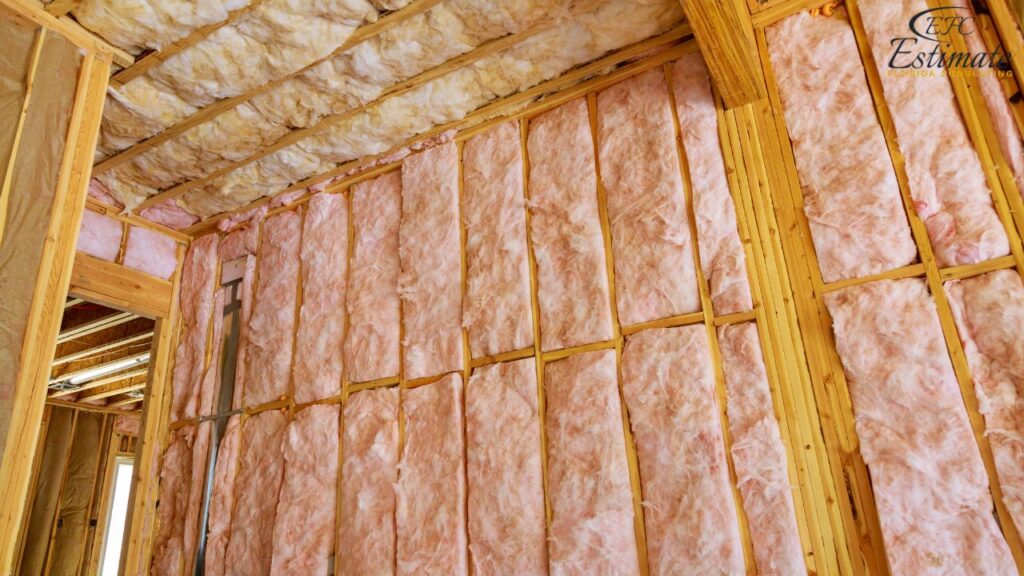
DIY Installation:
While some homeowners may consider DIY installation to save on labor costs, this is generally not recommended for duct insulation due to the precision required to ensure a proper seal and fit. Improper installation can lead to gaps in the insulation, reducing its effectiveness and potentially causing air leaks or condensation issues. If you do choose to install duct insulation yourself, it’s crucial to follow all safety guidelines and use the correct tools and materials. DIY projects also require a significant time investment, and without proper experience, the quality of the installation may not match that of a professional job, potentially leading to higher long-term costs due to inefficiencies or the need for rework.
Additional Costs: Sealing, Repairs, and Access Issues
In addition to the cost of materials and labor, there are additional expenses to consider when budgeting for duct insulation, including sealing, repairs, and access issues. Addressing these factors is essential for ensuring that your insulation project is both effective and comprehensive, providing maximum benefits to your HVAC system.
Sealing Costs:
Before insulating ducts, it’s important to ensure that they are properly sealed to prevent air leaks. The cost of sealing ductwork typically ranges from $1.30 to $3.90 per linear foot. Sealing involves applying mastic or foil tape to the seams and joints of the ducts, creating an airtight barrier that enhances the effectiveness of the insulation. Properly sealed ducts can prevent up to 30% of air loss, significantly improving the efficiency of your HVAC system and reducing energy waste. Failing to seal ducts before insulation can result in reduced performance and negate some of the benefits of insulation.
Repair Costs:
If your ductwork is damaged or deteriorated, repairs may be necessary before insulation can be installed. The cost of duct repairs can vary widely depending on the extent of the damage and the complexity of the repair, typically ranging from $260 to $1,300. Addressing any necessary repairs during the insulation process is important for ensuring the long-term reliability and efficiency of your HVAC system. Ignoring duct damage can lead to ongoing energy loss, poor air quality, and potential system failures, which can be much more costly to address in the future.
Access Issues:
Ducts located in hard-to-reach areas, such as attics, crawl spaces, or within walls, may require additional labor and time to access and insulate. The cost of insulating ducts in these areas may be higher due to the added complexity and effort required. It’s important to consider any potential access issues when planning your insulation project and budget accordingly. Additionally, some areas may require specialized equipment or techniques to properly insulate, further increasing the cost. Ensuring that all parts of your duct system are accessible and properly insulated is crucial for achieving the full benefits of your insulation investment.
Duct Insulation Costs by Project Scope and Application
Here’s a breakdown of estimated duct insulation costs by application, providing you with a clear understanding of how different project types impact overall costs:
Application | Estimated Duct Insulation Cost per Linear Foot | Total Cost Range |
Residential Duct Insulation | $1.50 – $3 | $500 – $5,000 (depending on length and complexity) |
Commercial Duct Insulation | $2 – $4.50 | $1,000 – $20,000 (depending on length and complexity) |
Industrial Duct Insulation | $2.50 – $6 | $2,500 – $50,000 (depending on length and complexity) |
HVAC System Duct Insulation | $1.50 – $5 | $1,500 – $25,000 (depending on length and complexity) |
Estimating the Total Cost: A Detailed Example for a Residential Duct Insulation Project
To provide a clearer understanding of what to expect, here’s an example of estimating the cost for insulating 100 linear feet of ductwork in a residential HVAC system using fiberglass insulation, including labor, sealing, and potential repairs. This example takes into account the most common variables that affect duct insulation costs and provides a realistic estimate for a typical project.
- Fiberglass Insulation: $2.60 – $7.80 per linear foot
- Professional Installation: $3.90 – $10.40 per linear foot
- Sealing: $1.30 – $3.90 per linear foot
- Repairs (if needed): $260 – $1,300
Cost Component | Low Estimate | High Estimate |
Fiberglass Insulation (100 ft.) | $260 | $780 |
Professional Labor (100 ft.) | $390 | $1,040 |
Sealing (100 ft.) | $130 | $390 |
Repairs | $260 | $1,300 |
Total Estimated Cost | $1,040 | $3,510 |
This example demonstrates how various components contribute to the overall cost of your duct insulation project. By understanding these costs, you can better plan your budget and ensure that all aspects of the project are covered, leading to a successful and efficient HVAC system. Proper planning also helps you avoid unexpected expenses, ensuring that your project stays within budget. The detailed breakdown provides transparency and allows you to see exactly where your money is being spent, helping you make informed decisions throughout the process. Additionally, considering the potential for energy savings and improved comfort, the investment in duct insulation can offer significant long-term value.
Duct Insulation Cost by Material
The cost of duct insulation varies significantly depending on the type of material used. Each insulation material offers distinct advantages in terms of thermal resistance (R-value), durability, and installation complexity, all of which influence the overall price. Choosing the right insulation material is crucial, as it directly impacts the energy efficiency and performance of your HVAC system. Below, we explore the costs associated with different duct insulation materials, along with their key benefits and considerations.
Duct Insulation Material | Price per Square Foot (Material Only) | Price per Square Foot (Installed) |
Fiberglass Insulation | $1.04 – $3.12 | $3.12 – $7.02 |
Reflective Foil Insulation | $1.30 – $3.90 | $3.90 – $7.80 |
Foam Board Insulation | $1.95 – $5.46 | $5.85 – $10.14 |
Spray Foam Insulation | $3.12 – $7.80 | $7.80 – $13.26 |
Mineral Wool Insulation | $2.34 – $6.24 | $6.24 – $10.92 |
Fiberglass Insulation:
Fiberglass insulation is one of the most widely used materials for duct insulation, prized for its cost-effectiveness and solid thermal resistance. The cost of fiberglass insulation typically ranges from $1.04 to $3.12 per square foot for the material, with installation costs ranging from $3.12 to $7.02 per square foot. This insulation is available in various forms, including batts, rolls, and duct wraps, making it a versatile option for different duct configurations. Its affordability and ease of installation make it a popular choice for residential and commercial applications. However, fiberglass insulation can lose its effectiveness over time if it becomes compressed or wet, so proper installation and maintenance are key to ensuring its long-term performance.
Reflective Foil Insulation:
Reflective foil insulation is designed to reflect radiant heat away from the ducts, helping to maintain the temperature of the air inside the ductwork. The cost of reflective foil insulation typically ranges from $1.30 to $3.90 per square foot for the material, with installation costs ranging from $3.90 to $7.80 per square foot. This type of insulation is lightweight, easy to install, and particularly effective in reducing heat gain in warmer climates. Reflective foil insulation is often used in attics and other spaces where ducts are exposed to high levels of radiant heat. While it excels in reflecting heat, it may need to be combined with other types of insulation to achieve optimal thermal resistance, especially in colder climates.
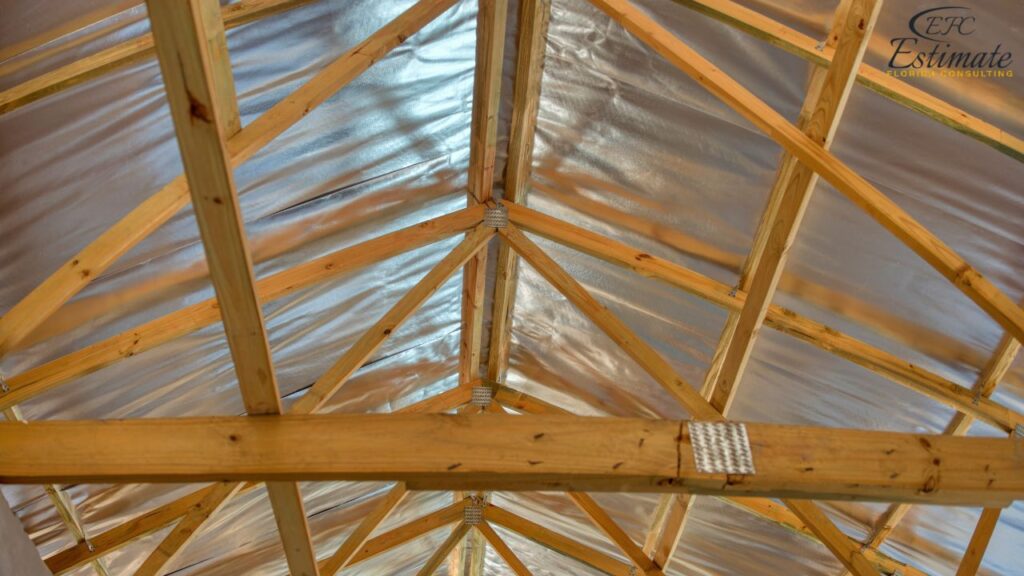
Foam Board Insulation:
Foam board insulation is a rigid, durable material that provides excellent thermal resistance, making it ideal for situations where space is limited but high insulation value is required. The cost of foam board insulation typically ranges from $1.95 to $5.46 per square foot for the material, with installation costs ranging from $5.85 to $10.14 per square foot. Foam board is commonly used in insulating ductwork located in unconditioned spaces like attics, basements, or crawl spaces. It is highly resistant to moisture and provides a continuous insulation layer that minimizes thermal bridging. However, due to its rigidity, foam board insulation can be more challenging to install around complex duct shapes or in tight spaces, which may increase labor costs.
Spray Foam Insulation:
Spray foam insulation offers superior coverage and thermal resistance, making it ideal for insulating irregularly shaped or hard-to-reach ductwork. The cost of spray foam insulation typically ranges from $3.12 to $7.80 per square foot for the material, with installation costs ranging from $7.80 to $13.26 per square foot. Spray foam forms an airtight seal that helps to reduce energy loss, prevent air leaks, and improve overall system efficiency. It expands upon application, filling gaps and crevices in the ductwork that other insulation materials might miss. This makes it particularly useful in older homes where ducts may have shifted or settled over time. While spray foam provides excellent insulation, it is generally more expensive and requires professional installation to ensure proper application and safety.
Duct Installation
Mineral Wool Insulation:
Mineral wool, also known as rock wool, is a fire-resistant and sound-absorbing insulation material that is often used in commercial or industrial settings. The cost of mineral wool insulation typically ranges from $2.34 to $6.24 per square foot for the material, with installation costs ranging from $6.24 to $10.92 per square foot. Mineral wool is made from natural stone and recycled materials, offering excellent thermal performance and resistance to fire, moisture, and mold. It is particularly valued in environments where fire safety and noise reduction are critical concerns. However, mineral wool insulation can be more difficult to handle and install than other types of insulation, which may increase labor costs. Its higher density also means it is more effective at blocking sound, making it a good choice for ducts in multi-family buildings or commercial properties where noise control is important.
Duct Insulation Cost by Project Type
The cost of duct insulation is also influenced by the specific project type, such as whether you’re insulating new ducts, upgrading existing insulation, or replacing old insulation. Each project type presents unique challenges and considerations that affect both the material and labor costs. Below, we break down the estimated costs for various duct insulation projects to help you plan your budget more accurately.
Project Type | Cost Range |
New Duct Insulation Installation | $780 – $4,680 |
Insulation Replacement | $520 – $3,120 |
Insulation Upgrade for Existing Ducts | $650 – $3,900 |
Insulation for Commercial Ductwork | $1,560 – $7,800 |
Sealing and Insulating Leaky Ducts | $390 – $2,340 |
New Duct Insulation Installation:
Installing insulation on new ducts is an essential step in ensuring the energy efficiency and performance of your HVAC system from the outset. This type of project typically costs between $780 and $4,680, depending on the size of the ductwork, the type of insulation material chosen, and the complexity of the installation. New installations often require additional steps such as sealing duct joints, securing the insulation, and ensuring that the ducts are properly supported. The choice of insulation material will also play a significant role in the overall cost, with more advanced materials like spray foam or foam board costing more but offering better long-term energy savings.
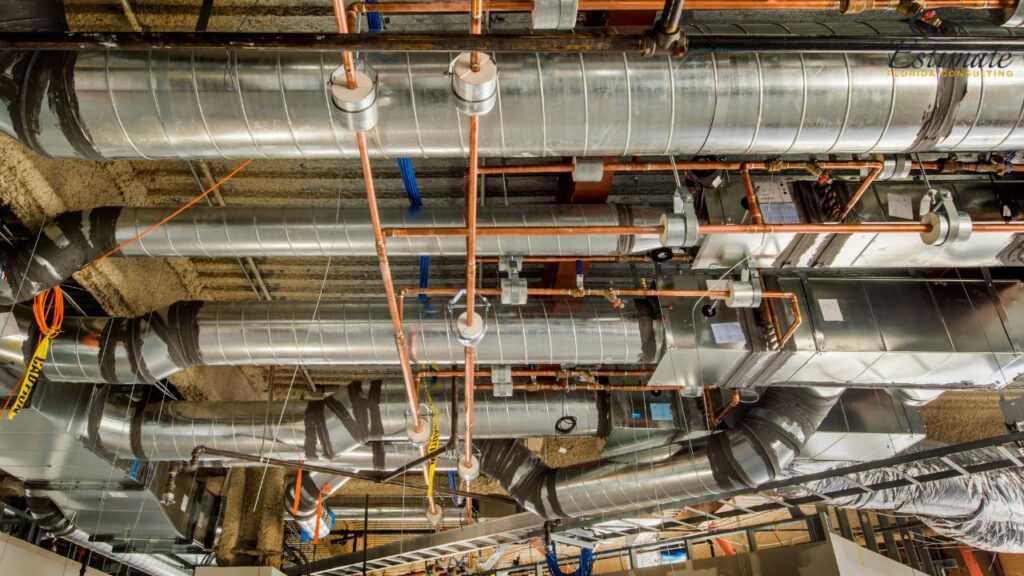
Insulation Replacement:
Over time, duct insulation can degrade, become damaged, or lose its effectiveness due to factors like moisture infiltration, compression, or general wear and tear. Replacing old or damaged insulation is crucial to maintaining the efficiency of your HVAC system and ensuring consistent indoor temperatures. This type of project typically costs between $520 and $3,120, depending on the extent of the replacement and the type of insulation used. Replacement projects are generally less expensive than new installations because the existing ductwork is already in place. However, if the old insulation has caused or is accompanied by issues such as mold growth, corrosion, or structural damage to the ducts, additional repair costs may be necessary.
Insulation Upgrade for Existing Ducts:
Upgrading the insulation on existing ducts can significantly improve energy efficiency, reduce utility bills, and bring the system up to current building code standards. This type of project typically costs between $650 and $3,900, depending on the current state of the duct insulation, the type of new insulation being installed, and the size of the system. Upgrades are particularly important in older homes or buildings where the original insulation may no longer meet modern energy efficiency standards. Upgrading insulation might also involve adding additional layers or combining different types of insulation materials to achieve the desired R-value and thermal performance.
Insulation for Commercial Ductwork:
Insulating ductwork in commercial settings is often more complex and costly than residential projects due to the larger scale of the systems and the need for higher-performance materials. Commercial duct insulation typically costs between $1,560 and $7,800, depending on the size of the building, the complexity of the HVAC system, and the specific insulation requirements. In commercial settings, additional considerations such as fire safety, noise control, and adherence to stricter building codes may influence both the choice of insulation material and the overall cost. The use of more robust insulation materials like mineral wool or spray foam is common in these environments to meet higher performance demands.
Sealing and Insulating Leaky Ducts:
Leaky ducts can significantly reduce the efficiency of your HVAC system, leading to higher energy bills and uneven heating or cooling throughout your space. Sealing and insulating these leaks is an effective way to restore efficiency and improve indoor comfort. This type of project typically costs between $390 and $2,340, depending on the extent of the leaks and the amount of insulation required. Sealing involves applying specialized materials to the joints and seams of the ducts to prevent air leakage, followed by the installation of insulation to maintain the desired temperature. This process not only enhances the energy efficiency of your HVAC system but also improves indoor air quality by preventing the infiltration of dust, pollutants, and allergens through the ductwork.
Duct Insulation Cost Estimation
Accurate cost estimation is essential for the success of any duct insulation project. It helps prevent unexpected expenses that could disrupt your budget and timeline, ensuring that your project stays on track from start to finish. Misestimating the amount of insulation required, the type of material, or the complexity of the installation can lead to significant cost overruns and delays, which can negatively impact the overall success of the project. A precise estimate allows you to manage your resources more effectively, ensuring that the right materials and labor are available when needed. Estimate Florida Consulting provides accurate estimate services that deliver the precision needed to keep your project on budget and on schedule, ensuring that it meets the highest standards of quality and efficiency.
Get 5 New Leads Next 7 Days With Our System
- Multi-Family House
- Single-Faimly House
- Modern House
- Duplex
- Ranch House
- Bungalow
Duct Insulation Cost Calculator
To assist you in planning and budgeting your duct insulation project more accurately, Estimate Florida Consulting provides estimate services that include a comprehensive cost calculator. This tool allows you to input specific details about your project, such as the type of insulation, the total length of ducts to be insulated, and the complexity of the installation. The calculator then provides an estimated cost range tailored to your project’s specific needs, offering you a clear understanding of what to expect financially. This cost calculator is an invaluable resource that helps ensure your project plans align with your budget, allowing you to allocate the necessary financial resources effectively.
Why Invest in Duct Insulation? Energy Efficiency, Comfort, and Cost Savings
Investing in duct insulation is essential for optimizing the performance of your HVAC system. Insulated ducts help maintain the desired temperature of the air as it moves through the system, reducing energy loss and improving overall efficiency. Without proper insulation, a significant amount of energy can be wasted as heat escapes or enters the ductwork, leading to higher energy consumption and increased utility bills. Additionally, insulation helps protect the ducts from external temperature fluctuations, ensuring that your system operates more consistently and efficiently.
Energy Efficiency
Insulated ducts help reduce heat loss in the winter and heat gain in the summer, ensuring that the air delivered to each room is at the desired temperature. This efficiency reduces the workload on your HVAC system, leading to lower energy consumption and utility bills. By minimizing the energy required to maintain comfortable indoor temperatures, duct insulation can make your heating and cooling system much more cost-effective. Proper insulation also helps prevent condensation on ducts, which can lead to moisture-related issues like mold growth, further protecting your home or business from potential damage.
Comfort
By preventing temperature fluctuations in the ducts, insulation helps maintain a more consistent indoor climate. This means that each room in your home or business will receive air at the intended temperature, improving overall comfort. Without insulation, you might experience uneven temperatures from room to room, leading to discomfort and the need for constant thermostat adjustments. Insulated ducts also reduce noise, as the insulation helps dampen the sound of air moving through the system, contributing to a quieter indoor environment and a more pleasant living or working space.
Cost Savings
While duct insulation involves an upfront cost, the long-term savings on energy bills can more than offset this initial investment. Insulated ducts improve the efficiency of your HVAC system, reducing the amount of energy required to heat or cool your space. Over time, these savings can add up, making duct insulation a cost-effective choice for homeowners and businesses alike. In addition to lowering your energy bills, investing in insulation can also extend the lifespan of your HVAC system by reducing the strain on its components, ultimately saving you money on repairs and replacements.
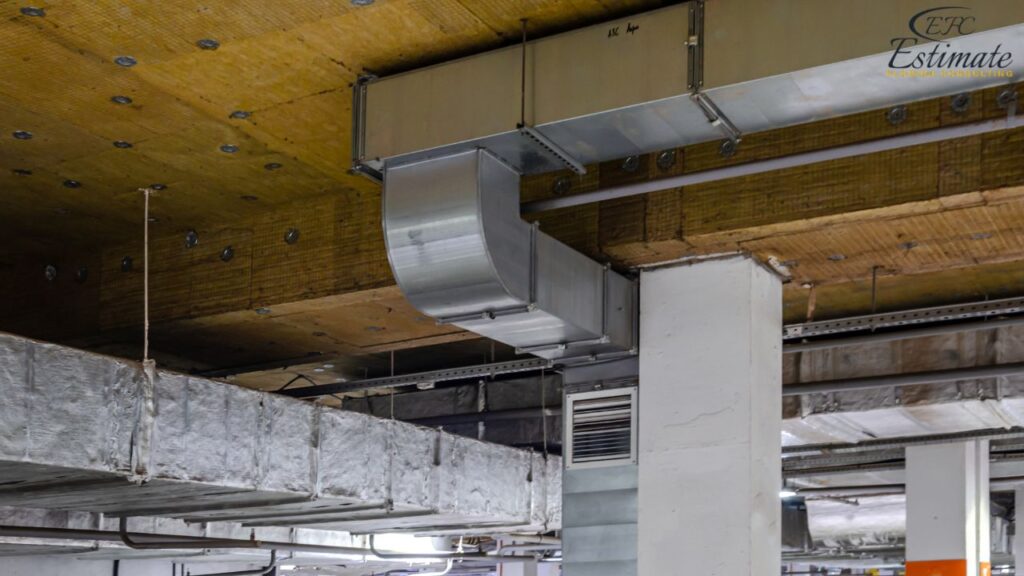
Long-Term Benefits of Investing in Duct Insulation
Investing in duct insulation offers numerous long-term benefits that can significantly impact the efficiency, performance, and lifespan of your HVAC system. By choosing high-quality materials and ensuring proper installation, you can enjoy a reliable and cost-effective system that meets your heating and cooling needs for years to come. These benefits extend beyond immediate cost savings, contributing to the overall health, safety, and comfort of your indoor environment.
Energy Savings
One of the most significant benefits of duct insulation is the potential for energy savings. By preventing heat loss and gain, insulated ducts reduce the amount of energy required to maintain the desired temperature in your home or business. This efficiency translates into lower energy bills, as your HVAC system can operate more effectively without the need to constantly compensate for temperature fluctuations. Over time, these savings can add up, offsetting the initial cost of insulation and providing a positive return on investment. In addition to reducing your utility bills, energy-efficient systems are often more environmentally friendly, helping to reduce your carbon footprint.
Improved Indoor Air Quality
Proper duct insulation helps improve indoor air quality by preventing contaminants from entering the ductwork and circulating throughout your home or business. Insulation helps maintain the integrity of the ducts, reducing the risk of leaks and infiltration of dust, mold, and other pollutants. This is particularly important for individuals with allergies or respiratory issues, as poor indoor air quality can exacerbate these conditions. By investing in duct insulation, you can create a healthier indoor environment, improving the comfort and well-being of your family or employees. Additionally, well-insulated ducts are less likely to develop condensation, which can lead to mold growth and other moisture-related problems.
Download Template For Duct Insulation Project Breakdown
- Materials list updated to the zip code
- Fast delivery
- Data base of general contractors and sub-contractors
- Local estimators
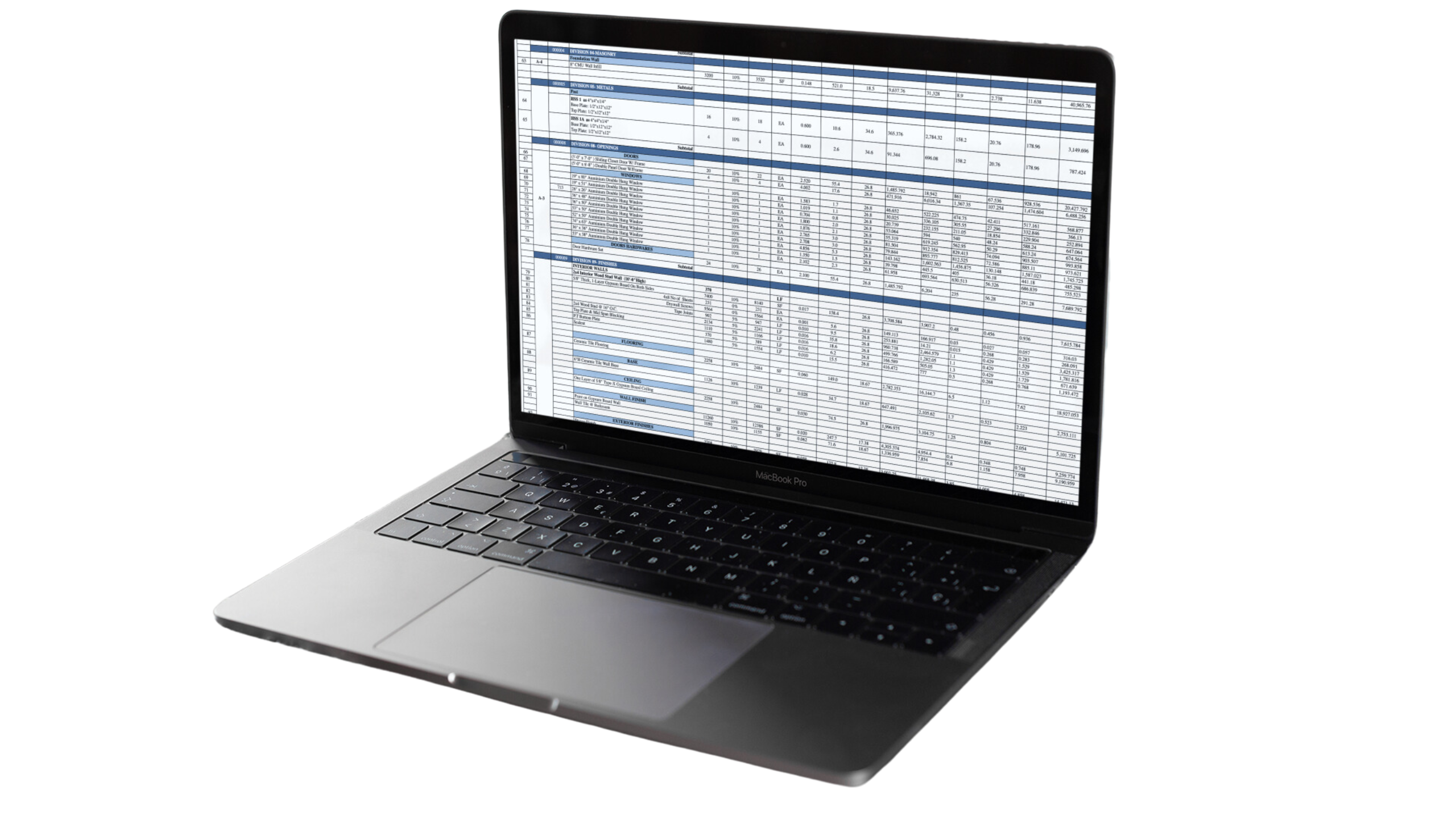
Extended HVAC System Lifespan
Insulated ducts reduce the strain on your HVAC system by maintaining consistent temperatures and preventing energy loss. This reduced strain can extend the lifespan of your system, delaying the need for costly repairs or replacements. An HVAC system that operates more efficiently is less likely to experience wear and tear, helping to ensure that it remains reliable and effective for many years. By protecting your investment in your HVAC system, duct insulation can help you avoid the high costs associated with premature system failures or frequent repairs, contributing to long-term financial savings and peace of mind.
Conclusion
Accurate cost estimation is the foundation of a successful duct insulation project. Estimate Florida Consulting provides comprehensive and precise estimate services that help you plan and execute your project with confidence. By understanding the cost components and potential variables, you can make informed decisions that align with your budget and project goals. Contact us today to get started with your duct insulation cost estimator services, and take the first step toward creating an efficient, comfortable, and cost-effective HVAC system. With our expert guidance and detailed cost breakdowns, you can be assured that your project will be completed on time, within budget, and to the highest standards of quality and performance. Our commitment to excellence ensures that every aspect of your project is handled with the utmost care and professionalism, resulting in a duct insulation system that not only meets your needs but also enhances the overall efficiency and comfort of your property.
FAQs
Duct insulation involves adding insulating materials around HVAC ducts to enhance energy efficiency, reduce heat loss, and maintain consistent indoor temperatures. Proper duct insulation helps ensure that heated or cooled air reaches its destination without significant energy loss, improving overall system performance and reducing operational costs.
Several factors affect the cost of duct insulation, including:
- Type of Insulation Material: Fiberglass, foam, or reflective insulation each have different cost implications.
- Size and Length of Ducts: Larger ducts or longer runs require more insulation material, increasing costs.
- Labor Costs: Professional installation costs vary based on the complexity of the job.
- Additional Expenses: Sealing, repairs, and access issues can also impact the total cost.
The type of duct insulation you choose greatly influences the overall cost:
- Fiberglass Insulation: $2.60 – $7.80 per linear foot
- Foam Insulation: $5.20 – $13.00 per linear foot
- Reflective Insulation: $3.90 – $9.10 per linear foot
The size and length of the ducts are crucial in determining the amount of insulation needed:
- 6-inch Diameter Ducts: $2.60 – $5.20 per foot (fiberglass)
- 8-inch Diameter Ducts: $3.90 – $6.50 per foot (fiberglass)
- 12-inch Diameter Ducts: $6.50 – $9.10 per foot (fiberglass) Larger or longer ducts increase the total cost due to the need for more insulation material and potentially more labor.
Labor costs can vary significantly:
- Professional Installation: $3.90 – $10.40 per linear foot
- DIY Installation: Varies (not recommended for most projects due to the complexity and need for precision).
In addition to the insulation material and labor, other costs include:
- Sealing Costs: $1.30 – $3.90 per linear foot
- Duct Repairs: $260 – $1,300, depending on the extent of the damage.
- Access Issues: Additional costs may arise if ducts are located in hard-to-reach areas, such as attics or crawl spaces.
Duct insulation costs depend on the specific project:
- Residential Duct Insulation: $1.50 – $3.00 per linear foot; $500 – $5,000 total cost range
- Commercial Duct Insulation: $2.00 – $4.50 per linear foot; $1,000 – $20,000 total cost range
- Industrial Duct Insulation: $2.50 – $6.00 per linear foot; $2,500 – $50,000 total cost range
For a residential project involving 100 linear feet of ductwork:
- Fiberglass Insulation: $260 – $780
- Professional Labor: $390 – $1,040
- Sealing: $130 – $390
- Repairs (if needed): $260 – $1,300
- Total Estimated Cost: $1,040 – $3,510
Investing in duct insulation offers several benefits:
- Energy Efficiency: Reduces heat loss and gain, lowering energy bills.
- Improved Comfort: Maintains consistent indoor temperatures, enhancing comfort.
- Cost Savings: Long-term savings on energy bills offset the initial investment.
- Extended HVAC Lifespan: Reduces strain on the system, prolonging its life.
Improved Indoor Air Quality: Prevents contaminants from entering the ductwork.
Estimate Florida Consulting offers a comprehensive cost calculator that considers the type of insulation, duct length, and installation complexity. This tool provides an estimated cost range tailored to your project’s specific needs, helping you plan your budget more effectively.
Google Reviews

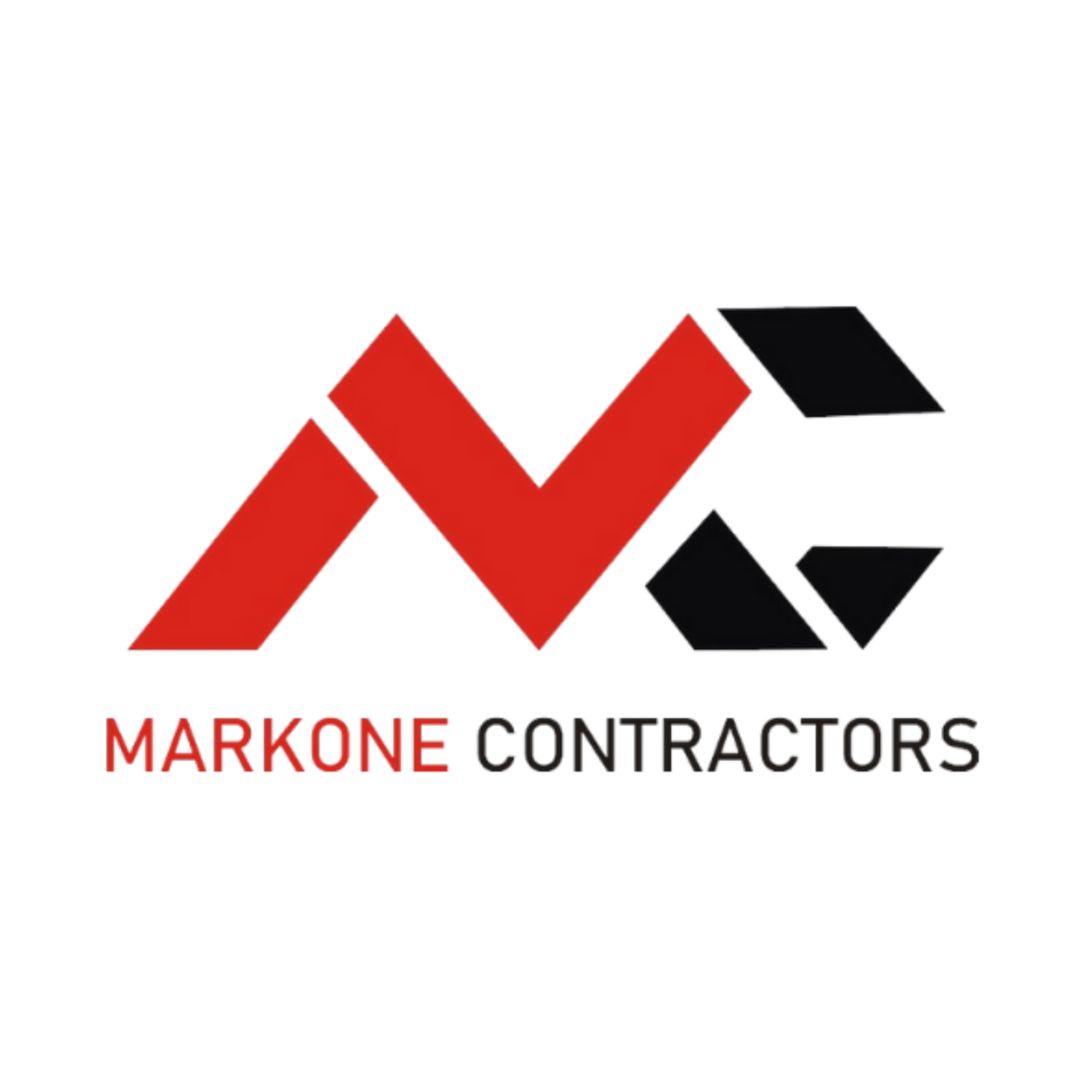

Process To Get Duct Insulation Cost Estimate Report
Here I am going to share some steps to get duct insulation cost estimate report.
-
You need to send your plan to us.
You can send us your plan on info@estimatorflorida.com
-
You receive a quote for your project.
Before starting your project, we send you a quote for your service. That quote will have detailed information about your project. Here you will get information about the size, difficulty, complexity and bid date when determining pricing.
-
Get Estimate Report
Our team will takeoff and estimate your project. When we deliver you’ll receive a PDF and an Excel file of your estimate. We can also offer construction lead generation services for the jobs you’d like to pursue further.

